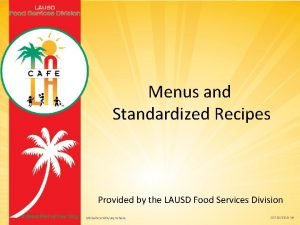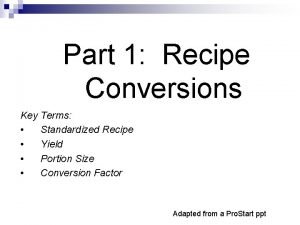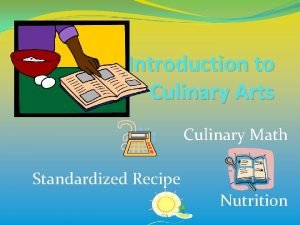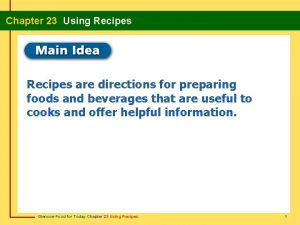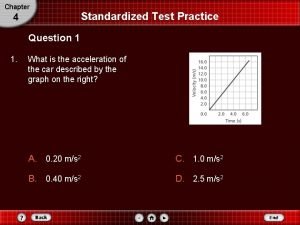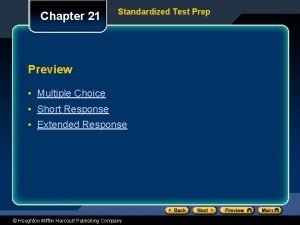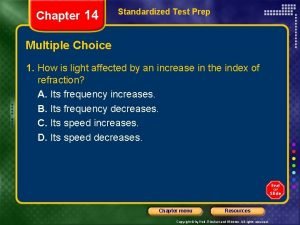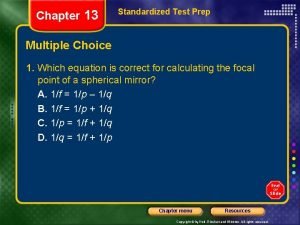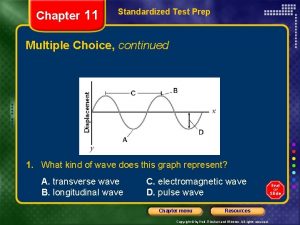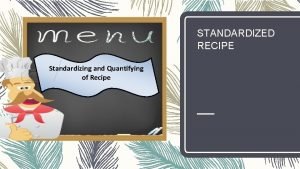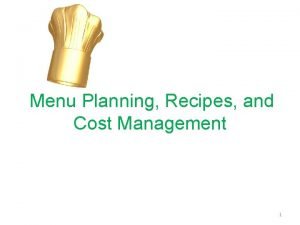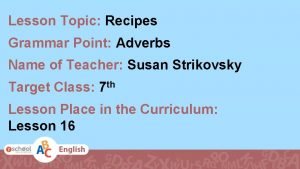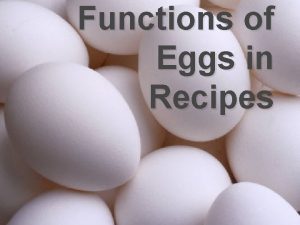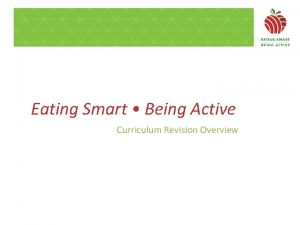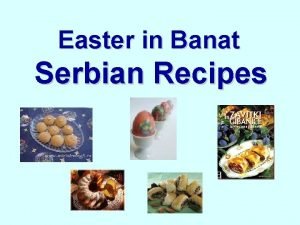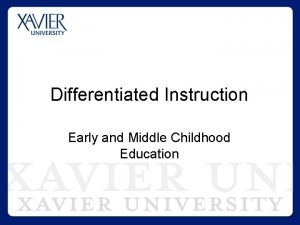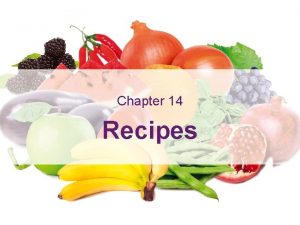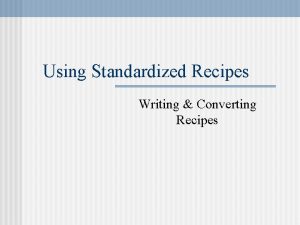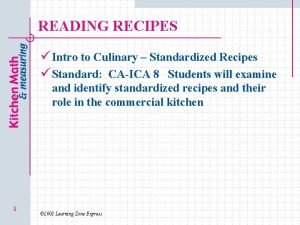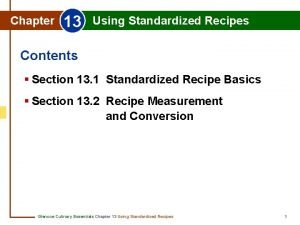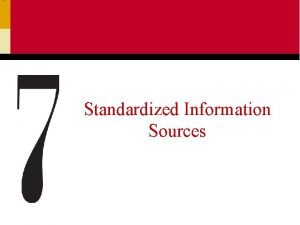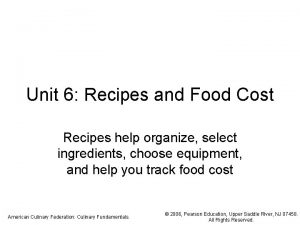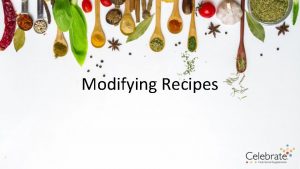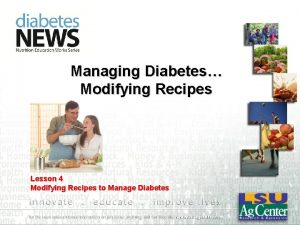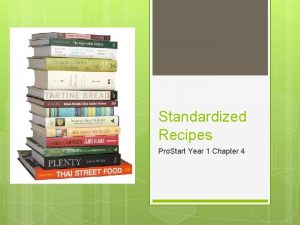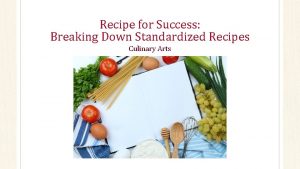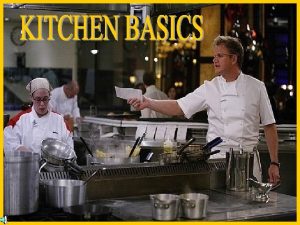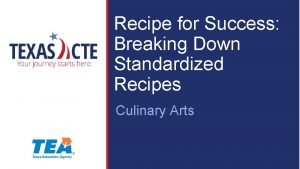Chapter 13 Using Standardized Recipes Section 13 1























- Slides: 23

Chapter 13 Using Standardized Recipes Section 13. 1 Standardized Recipe Basics • Recipes provide specific instructions to prepare food items. • A recipe includes details on how to use ingredients, procedures, and cooking instructions. Glencoe Culinary Essentials Chapter 13 Using Standardized Recipes 1

Chapter 13 Using Standardized Recipes • Standardized recipes can be changed, but each change must go through quality control A system that ensures that everything will meet the foodservice establishment’s standards. Glencoe Culinary Essentials Chapter 13 Using Standardized Recipes 2

Chapter 13 Using Standardized Recipes • Standardized recipe benefits: • consistent quality and quantity • standard portion size/cost • fewer errors in food orders • less waste • more easily meet customer expectations Glencoe Culinary Essentials Chapter 13 Using Standardized Recipes quantity The total amount a recipe makes. 3

Chapter 13 Using Standardized Recipes • The success of any standardized recipe depends on the experience of the person who uses it. standardized recipe A set of written instructions used to consistently prepare a known quantity and quality of food. Glencoe Culinary Essentials Chapter 13 Using Standardized Recipes 4

Chapter 13 Using Standardized Recipes Describe the different parts of a standardized recipe. Recipe Part Description Product Name The name given to the recipe; should be consistent with the name of the dish on the menu Yield The number of servings, or portions, that a recipe produces Portion Size The amount or size of an individual serving Glencoe Culinary Essentials Chapter 13 Using Standardized Recipes 5

Chapter 13 Using Standardized Recipes Describe the different parts of a standardized recipe. Recipe Part Description Ingredient Quantity Directions on how to measure each ingredient that is listed Preparation Procedures Steps that you must take to prepare the dish Cooking Temperatures and Times The temperatures and times that must be used for the dish to cook properly; these are usually listed together on a recipe Glencoe Culinary Essentials Chapter 13 Using Standardized Recipes 6

Chapter 13 Using Standardized Recipes • Baking is different from cooking because it involves chemical reactions. • Baked goods require precise formulas to work. formula A special type of recipe used in the bakeshop. Glencoe Culinary Essentials Chapter 13 Using Standardized Recipes 7

Chapter 13 Using Standardized Recipes • Three major differences between formulas and recipes are: • order of how ingredients are listed • inclusion of preparation instructions • baker’s percentage In a formula, includes the percentage of each ingredient in relation to the weight of flour in the final baked product. Glencoe Culinary Essentials Chapter 13 Using Standardized Recipes 8

Chapter 13 Using Standardized Recipes Section 13. 2 Recipe Measurement and Conversion • Sometimes, foodservice professionals need to adjust recipes to meet their needs. • Adjusted recipes should be tested before preparation, as many factors can affect conversion. Glencoe Culinary Essentials Chapter 13 Using Standardized Recipes 9

Chapter 13 Using Standardized Recipes Standardized Recipe Measurements • Sometimes it is necessary to convert recipes to make more or less of a dish. convert To adjust ingredient quantities in a standardized recipe. Glencoe Culinary Essentials Chapter 13 Using Standardized Recipes 10

Chapter 13 Using Standardized Recipes Standardized Recipe Measurements • Standardized recipe ingredients are measured by: • weight • volume • count The number of individual items used in a recipe. Glencoe Culinary Essentials Chapter 13 Using Standardized Recipes 11

Chapter 13 Using Standardized Recipes Standardized Recipe Measurements • Recipes measured using the metric system are easy to convert from one unit to another by simply moving the decimal place. metric system A mathematical system that uses powers of 10 to measure things. Glencoe Culinary Essentials Chapter 13 Using Standardized Recipes 12

Chapter 13 Using Standardized Recipes Standardized Recipe Measurements Glencoe Culinary Essentials Chapter 13 Using Standardized Recipes 13

Chapter 13 Using Standardized Recipes Standardized Recipe Measurements Glencoe Culinary Essentials Chapter 13 Using Standardized Recipes 14

Chapter 13 Using Standardized Recipes Standardized Recipe Measurements • Scales for measuring weight come in different types, sizes, and price ranges. If you needed to purchase a scale, what factors would you use to decide which one to buy? Glencoe Culinary Essentials Chapter 13 Using Standardized Recipes 15

Chapter 13 Using Standardized Recipes Standardized Recipe Measurements • Volume measurements are used most often to measure liquids, such as cups and gallons. volume measurement A measurement that is expressed in cups, quarts, gallons, and fluid ounces. Glencoe Culinary Essentials Chapter 13 Using Standardized Recipes 16

Chapter 13 Using Standardized Recipes Recipe Conversion • The conversion factor helps you increase or decrease the yield in a recipe. Desired Yield ÷ Existing Yield = Conversion Factor conversion factor The number that comes from dividing the yield you want by the existing yield in a recipe. Glencoe Culinary Essentials Chapter 13 Using Standardized Recipes 17

Chapter 13 Using Standardized Recipes Recipe Conversion • Multiply the existing quantity of an ingredient by the conversion factor to find the new ingredient quantity. Existing Quantity x Conversion Factor Glencoe Culinary Essentials Chapter 13 Using Standardized Recipes = New Quantity 18

Chapter 13 Using Standardized Recipes Recipe Conversion • Convert Portion Size 1. Multiply the number of existing portions by the existing portion size. Existing Portions x Existing Portion Size Glencoe Culinary Essentials Chapter 13 Using Standardized Recipes = Existing Yield 19

Chapter 13 Using Standardized Recipes Recipe Conversion • Convert Portion Size 2. Multiply the desired portions by the desired portion size to find the new yield. Desired Portions x Desired Portion Size Glencoe Culinary Essentials Chapter 13 Using Standardized Recipes = New Yield 20

Chapter 13 Using Standardized Recipes Recipe Conversion • Convert Portion Size 3. Divide the new yield by the existing yield to get the conversion factor. New Yield ÷ Existing Yield Glencoe Culinary Essentials Chapter 13 Using Standardized Recipes = Conversion Factor 21

Chapter 13 Using Standardized Recipes Recipe Conversion • Convert Portion Size 4. Multiply each ingredient by the conversion factor to get the new ingredient yield. Old Ingredient x Conversion Factor Glencoe Culinary Essentials Chapter 13 Using Standardized Recipes = New Ingredient Yield 22

Chapter 13 Using Standardized Recipes Recipe Conversion • Conversion calculations do not take into account certain factors: • equipment • mixing and cooking time shrinkage The percentage of • cooking temperatures food lost during its • shrinkage storage and preparation. • recipe errors Glencoe Culinary Essentials Chapter 13 Using Standardized Recipes 23
 Standardized recipes menu
Standardized recipes menu Standardized recipes menu
Standardized recipes menu What is a standard recipe
What is a standard recipe Chocolate chips
Chocolate chips Chapter 23 using recipes student activity workbook answers
Chapter 23 using recipes student activity workbook answers Chapter 23 using recipes answer key
Chapter 23 using recipes answer key 4-4 standardized test prep answers
4-4 standardized test prep answers Chapter 3 standardized test practice answers
Chapter 3 standardized test practice answers Chapter 21 standardized test practice answers
Chapter 21 standardized test practice answers Chapter 14 standardized test practice answers
Chapter 14 standardized test practice answers Chapter 13 standardized test practice answers
Chapter 13 standardized test practice answers Chapter 11 standardized test practice
Chapter 11 standardized test practice Chapter 2 chapter assessment
Chapter 2 chapter assessment Chapter 19 standardized test practice answers
Chapter 19 standardized test practice answers A rock climber's shoe loosens a rock and her climbing buddy
A rock climber's shoe loosens a rock and her climbing buddy Cded diet phase 1
Cded diet phase 1 What is a standardized recipe
What is a standardized recipe Foodafactoflife
Foodafactoflife Menus recipes and cost management
Menus recipes and cost management Site:slidetodoc.com
Site:slidetodoc.com Why is egg an emulsifier
Why is egg an emulsifier Eating smart being active recipes
Eating smart being active recipes Serbian easter recipes
Serbian easter recipes Early childhood development with differentiated instruction
Early childhood development with differentiated instruction

